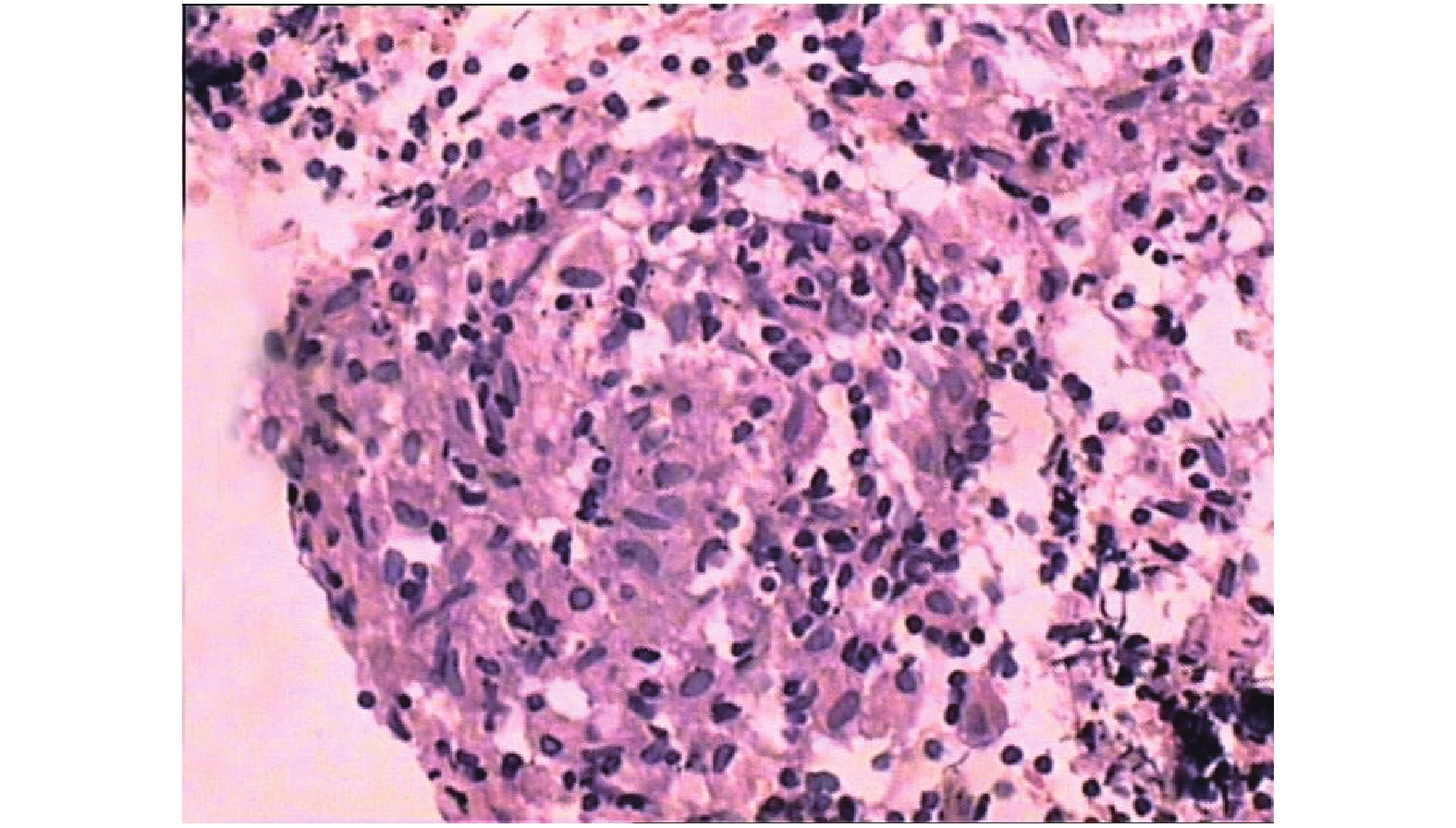Application Value of Endobronchial Ultrasound-guided Transbronchial Needle Aspiration in Diagnosis of Space-occupying Lesions of Lung and Mediastinum
-
摘要:
目的 探讨超声支气管镜引导下的经支气管针吸活检术(EBUS-TBNA)在肺和纵隔占位性病变诊断及肺癌分期中的应用价值。 方法 90例肺和纵隔占位病变施行超声支气管镜引导下的经支气管针吸活检术,穿刺的151份标本经石蜡包埋,HE染色,细胞病理学诊断,免疫细胞化学Ki67检测,对肺癌进行淋巴结分期,以组织病理学诊断结合临床共同诊断为标准,分析细胞学诊断的符合率及敏感性。 结果 EBUS-TBNA穿刺成功率100% (151/151),诊断率91.1% (82/90),肺和纵隔占位性病变在EBUS-TBNA术后诊断率显著提高(P < 0.01)。90例中恶性肿瘤占72.22% (65/90),良性病变占18.89% (17/90),8.89%未明确诊断(8/90)。细胞学查见恶性细胞57例,诊断敏感度为 87.69%,80%的肺癌获TNM分期(44/55)。肺结核及肉芽肿性炎Ki67阳性指数0~3%,肺恶性结节ki67阳性指数20%~80%,肺良性病变与恶性肿瘤Ki67表达差异有显著统计学意义(P < 0.01)。 结论 EBUS-TBNA 是一种安全、灵敏、准确的诊断方法,可显著提高肺和纵隔占位性病变的诊断成功率,对肺癌的分类、分期、治疗和预后判断均有重要的指导意义及临床应用价值,Ki67阳性指数是判断EBUS-TBNA穿刺细胞良恶性质的重要参考指标。 Abstract:Objective To investigate the value of transbronchial needle aspiration biopsy (EBUS-TBNA) guided by ultrasound bronchoscope in the diagnosis of lung and mediastinal space-occupying lesions and staging of lung cancer. Methods Ninety patients with space-occupying lesions of lung and mediastinum underwent transbronchial needle aspiration biopsy guided by ultrasound bronchoscope. 151 specimens were embedded in paraffin, stained with HE, and diagnosed by cytopathology. Ki67 was detected by immunocytochemistry. Lymph node staging was performed for lung cancer. The coincidence rate and sensitivity of cytological diagnosis were analyzed according to the criteria of histopathological diagnosis combined with clinical diagnosis. Results The success rate of EBUS-TBNA puncture was 100% (151/151), and the success rate of diagnosis was 91.1% (82/90). The diagnostic rate of lung and mediastinal space-occupying lesions after EBUS-TBNA was significantly increased (P < 0.01).Among 90 cases, malignant tumors accounted for 72.22% (65/90), benign lesions accounted for 18.89% (17/90), and 8.89% had no definite diagnosis (8/90). 57 cases of malignant cells were found by cytology. The sensitivity of cytopathological diagnosis was 87.69%. TNM staging was achieved in 80% of lung cancers (44/55). Ki67 positive index of pulmonary tuberculosis and granulomatous inflammation was 0-3%. The positive index of Ki67 in malignant pulmonary nodules ranged from 20% to 80%. There was significant difference in Ki67 expression between benign and malignant lung lesions (P < 0.01). Conclusions EBUS-TBNA is a safe, sensitive and accurate diagnostic method, which can significantly improve the diagnostic success rate of lung and mediastinal space-occupying lesions. It has important guiding significance and clinical application value for the classification, staging, treatment and prognosis of lung cancer. Ki67 positive index is an important reference index for judging the benign and malignant of EBUS-TBNA puncture cells. -
Key words:
- EBUS-TBNA /
- Lung cancer /
- Lung nodule /
- Tuberculosis /
- Sarcoidosis /
- Cytology /
- Ki-67
-
表 1 90例肺和纵隔占位性病变 EBUS-TBNA诊断结果
Table 1. EBUS-TBNA diagnostic results of 90 cases of pulmonary and mediastinal space occupying lesions
部位诊断 病例(n) 构成比(%) 肺(恶性肿瘤) 鳞状细胞癌 16 17.78 腺癌 20 22.22 小细胞癌 18 20.00 差分化癌 1 1.11 恶性肿瘤未分类 2 2.22 纵隔 弥漫性大B细胞淋巴瘤 1 1.11 霍奇金淋巴瘤 1 1.11 侵袭性胸腺瘤 1 1.11 梭形细胞癌 1 1.11 恶性肿瘤未分类 2 2.22 转移癌 2 2.22 良性病变 肺结核病 8 8.89 肉芽肿性炎 7 7.78 硬化性肺泡细胞瘤 1 1.11 结节病 1 1.11 无明确诊断 8 8.89 合计 90 100 表 2 44例肺癌的TNM分期
Table 2. TNM staging of 44 cases of lung cancer
TNM分期 例数(N) IB IIIA(N) IIIB(N) IVA(N) 局限期 广泛期 鳞状细胞癌 10 CT2N2M0(1)
CT3N2M0 (2)
CT2aN2M0(1)CT2N3M0(1) PT4N2M1a(1)
PT3N3M1 (1)
CT3N2M1(1)
CT4N2M0(1)
CT4N3M1a(1)腺癌 19 PT2aN0M0a(2) PT2N2M0(1)
CT4N0M0(1)
CT1bN2M0(1)PT1N2M0(1)
CTxN3M0(1)
CT4N2M0(1)
CT3N2M0(3)PT4N3M1(1)
CT2N2M1(1)
CT3N2M1(1)
CT4N2M1(2)
CT3NXM1(1)
CT4N3M1(1)CT1aN3M1b(1)小细胞肺癌 14 PT2N2M0(1)
CTxN2M0(1)
CT3N2M0(2)CT4N2M0(1) CT2N3M1(1)
CT4N3M1(3)2 3 差分化癌 1 CT4N3M1(1) 合计 44 2 11 8 18 2 3 备注:小细胞肺癌局限期指肿瘤仅限于一侧胸腔或在一个放射野的范围内,广泛期指病变超一侧胸腔,可有恶性胸腔和心包积液或血道转移。 -
[1] Yasufuku K,Nakajima T,Fujiwara T,et al. Role of endobronchial ultrasound-guided transbronchial needle aspiration in the management of lung cancer[J]. Gen Thorac Cardiovasc Surg,2008,56(6):268-276. doi: 10.1007/s11748-008-0249-4 [2] Detterbeck F C,Boffa D J,Kim A W,et al. The eighth edition lung cancer stage classification[J]. Chest,2017,151(1):193-231. doi: 10.1016/j.chest.2016.10.010 [3] Westcott J L,Rao N,Colley D P. Transthoracic needle biopsy of small pulmonary nodules[J]. Radiology,1997,202(1):97-103. doi: 10.1148/radiology.202.1.8988197 [4] Travis W D,Brambilla E,Nicholson A G,et al. The 2015 World Health Organization classification of lung tumors:impact of genetic,clinical and radiologic advances since the 2004 classification[J]. J Thora Oncol,2015,10(9):1243-1260. doi: 10.1097/JTO.0000000000000630 [5] Righi L,Franzi F,Montarolo F,et al. Endobronchial ultrasound-guided transbronchial needle aspiration (EBUS-TBNA)-from morphology to molecular testing[J]. J Thora Dis,2017,9(5):395-404. [6] Kim J,Kang H J,Moon S H,et al. Endobronchial ultrasound-guided transbronchial needle aspiration for re-biopsy in previously treated lung cancer[J]. Cancer Res Treat,2019,51(4):1488-1499. doi: 10.4143/crt.2019.031 [7] Muthu V,Sehgal I S,Dhooria S,et al. Endobronchial ultrasound-guided transbronchial needle aspiration:techniques and challenges[J]. J Cytol,2019,36(1):65-70. doi: 10.4103/JOC.JOC_171_18 [8] 韩非,张俭,孙加源,等. EBUS-TBNA细胞学检查对肺癌及结节病的诊断价值[J]. 上海交通大学学报(医学版),2011,31(12):1737-1740. doi: 10.3969/j.issn.1674-8115.2011.12.017 [9] Shiina Y,Sakairi Y,Wada H,et al. Sclerosing pneumocytoma diagnosed by preoperative endobronchial ultrasound-guided transbronchial needle aspiration (EBUS-TBNA)[J]. Surg Case Rep,2018,4(1):20. doi: 10.1186/s40792-018-0429-0 [10] 李维华, 纪小龙. 呼吸系统病理学[M]. 北京: 人民军医出版社, 2011: 331-334. [11] Erol S,Anar C,Erer O F,et al. The Contribution of ultrasonographic characteristics of mediastinal lymph nodes on differential diagnosis of tuberculous lymphadenitis from sarcoidosis[J]. Tanaffos,2018,17(4):250-256. [12] Trisolini R,Baughman R P,Spagnolo P,et al. Endobronchial ultrasound-guided transbronchial needle aspiration in sarcoidosis:Beyond the diagnostic yield[J]. Respirology,2019,24(6):531-542. doi: 10.1111/resp.13537 [13] Taguchi A,Arenberg D. Harnessing immune response to malignant lung nodules. Promise and challenges[J]. Am J Respir Crit Care Med,2019,199(10):1184-1186. [14] Gu Q,Feng Z,Liang Q,et al. Machine learning-based radiomics strategy for prediction of cell proliferation in non-small cell lung cancer[J]. Eur J Radiol,2019,118:32-37. doi: 10.1016/j.ejrad.2019.06.025 [15] 杨宁,金大成,陈猛,等. 人工智能在肺癌诊断中的研究进展[J]. 中国胸心血管外科临床杂志,2020,27(10):1-6. [16] Harris D,Saha S. Endobronchial ultrasound-guided biopsy for evaluation of suspected lung cancer[J]. Asian Cardiovasc Thora Ann,2019,27(6):471-475. doi: 10.1177/0218492319853184 -






 下载:
下载:










